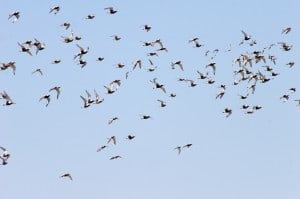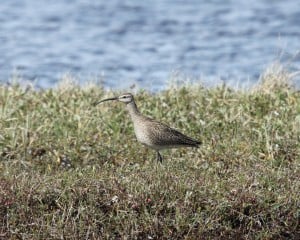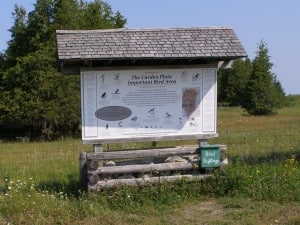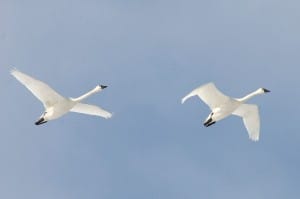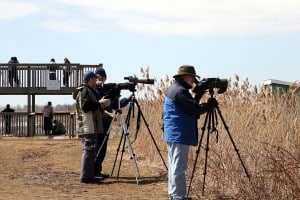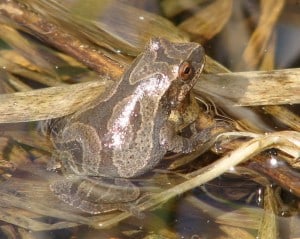The spectacle of bird migration that occurs twice each year in Canada has few equals anywhere on Earth. Billions of birds leave Canada every autumn for locations to the south, only to return the following spring and once again announce the change of season. Many of these migrating birds depend on a network of crucial feeding, resting, breeding and overwintering sites scattered throughout the Americas. Collaborative efforts that span international boundaries and focus on full life cycle conservation are therefore essential to ensure the long-term survival of bird populations.
The Important Bird Areas (IBA) network represents one such effort. The IBA Program is a global initiative coordinated by BirdLife International to identify, monitor, and conserve a network of the world’s most important sites providing habitat for birds. The program uses scientific criteria to identify potential IBAs. Sites can qualify based on the regular presence of significant numbers of species at risk, species with restricted ranges, habitat-specific species and species that gather in significant numbers (greater than 1% of their continental or global population). IBAs range in size from tiny patches of habitat to large tracts of land or water. They may encompass private or public land and sometimes overlap legally protected sites. The majority of IBAs, however, have no formal protection.
Because IBAs are identified using criteria that are internationally agreed upon and science-based, they have a conservation currency that transcends international borders. This, in turn, promotes international collaboration for the conservation of the world’s birds. About 90 percent of Canada’s birds migrate within and beyond our borders, so it is essential to protect these species throughout their annual migratory range. By working alongside partners in the United States, the Caribbean and Latin America, the IBA Program does this.
In Canada the IBA Program is managed jointly by Bird Studies Canada and Nature Canada. To date, nearly 600 sites have been designated. Most sites in Canada qualify for IBA designation because they regularly host globally or continentally significant numbers of a given bird species. Most Canadian IBAs are located along our Atlantic, Pacific and Arctic coasts, on the Great Lakes and on the Prairies. Some are extremely remote, while others are actually located within our largest urban centres. These sites are not only critical for birds, but also for many other kinds of plants and animals. They are also a great place for the public to connect with nature. Ontario’s 70 IBAs cover more than 23,000 square kilometers, and are located mostly along the Great Lakes and the coasts of Hudson and James Bays where birds naturally concentrate. To see a short video of huge numbers of migrating Hudsonian Godwits in James Bay, go to bit.ly/1lLZSOa
IBAs near Peterborough
1. Presqu’ile Provincial Park (Brighton) – At least two species are regularly present during spring migration in globally significant numbers. They are Greater Scaup and Whimbrel. In addition, the park supports globally significant breeding populations of Ring-billed Gulls and Caspian Terns.
2. Carden Plain (Kirkfield) – This is one of the few areas in eastern Canada that still supports nesting Loggerhead Shrikes, a nationally endangered species. Several other nationally threatened species nest in the area, too, including Red-shouldered Hawk, Short-eared Owl, Least Bittern and Red-headed Woodpecker.
3. Napanee Limestone Plain (Napanee) – This site is very similar to the Carden Plain and together they provide nesting habitat for most of the remaining Loggerhead Shrikes in eastern Canada.
4. Prince Edward County South Shore (Picton) – The number and diversity of landbirds that concentrate in this small area during spring and fall migration is outstanding. A total of 162 landbird species (excluding raptors) have been recorded at this site including 36 species of wood warblers. The shoals and deep waters off the tip of the peninsula represent a globally significant waterfowl staging and wintering area for Greater Scaup, Long-tailed Duck and White-winged Scoter.
5. The Leslie Street Spit (Toronto) – Ring-billed Gulls and Common Terns nest on “the spit” in globally significant numbers. There is also one of the largest Black-crowned Night Heron colonies in Canada. Large concentrations of migrating songbirds can be found here in the spring and fall as well as migrant ducks from fall through spring.
Other nearby IBAs within a two- or three-hour drive of Peterborough include the West End of Lake Ontario (Hamilton), Wye Marsh (Midland), Tiny Marsh (Elmvale) and Matchedash Bay (Waubaushene).
Website
One of the recent accomplishments of the IBA program in Canada is the development of a comprehensive website (www.ibacanada.org) which provides detailed information on Important Bird Areas across the country. By using the website map viewer or site directory, you can easily access a great deal of information on each IBA, including a site description, a summary of the most significant bird life, a discussion of conservation issues, a printable map of the area and an eBird link to report your own sightings while visiting the IBA. There is also a very useful seasonable abundance chart for all bird species found there.
Get involved
Getting involved in the IBA Program can be as simple as visiting an IBA and using eBird Canada (www.ebird.ca) to report the bird species you find there. However, a current focus of the IBA Program is to develop a national Caretaker Network to engage citizens in conservation actions. These volunteers can monitor bird populations, conduct IBA assessments, report on threats, work with partners on stewardship activities, and/or help build community awareness about the importance of IBAs. Caretakers can be clubs, individuals, or groups of individuals that share the common goal. Volunteers are equipped with the tools they require to be effective observers, advocates and citizen scientists. If you or your group would be interested in helping in this regard please contact Mike Burrell, Important Bird Areas Coordinator, Bird Studies Canada at 1-888-448-BIRD(2473) x 167 or by email at mburrell@birdscanada.org
Ontario Reptile and Amphibian Atlas Needs Volunteers
The familiar voices of frogs and toads will soon fill the day and evening air throughout the Kawarthas. Sadly, though, Ontario’s reptiles and amphibians are becoming increasingly rare. In fact, three quarters (18 of 24) of Ontario’s reptile species are already listed as species at risk. More information is needed, however, to monitor changes in the ranges of these animals as well as fluctuations in their populations. The data also helps to identify and manage important habitat for rare species. Volunteers can play an important role in this effort. Please consider sharing any observations you make of Ontario’s reptiles and amphibians. Observations can be submitted via an online form, an Excel spreadsheet (useful for submitting multiple observations) or a printable data card that can be mailed in. Visit the Atlas website by going to ontarionature.org, clicking on Protect and scrolling down to Species. You can also contact Jon Boxall at (705)743-6668 or by email at jbboxall@hotmail.com Presentations and training workshops for groups that are interested in participating in the Atlas project are also available.
